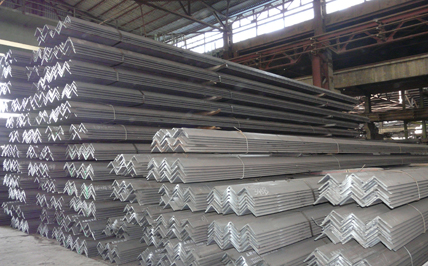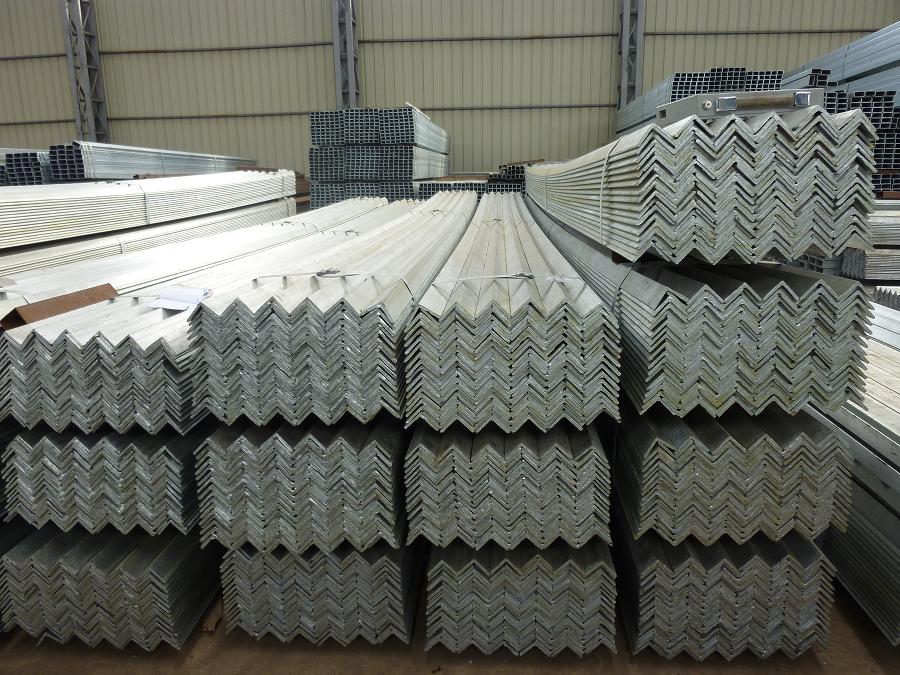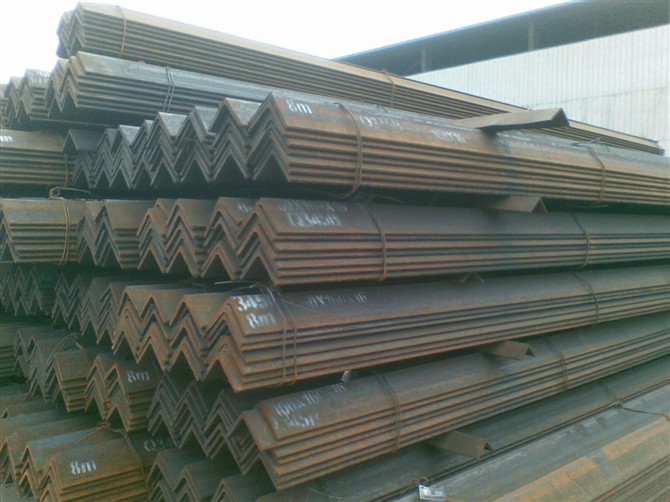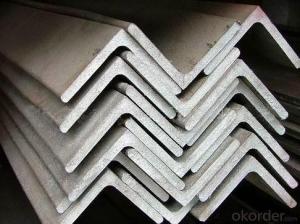Equal Angle Steel Mild Steel Hot Rolled for Infrastructure Project
- Loading Port:
- Tianjin
- Payment Terms:
- TT OR LC
- Min Order Qty:
- 25 m.t.
- Supply Capability:
- 20000 m.t./month
OKorder Service Pledge
OKorder Financial Service
You Might Also Like
Working Today, Building Tomorrow!
We do care:
--Good Quality
--On-time Delivery
--Competitive Price
--Efficient After Service
Our products are sold to all over the country and exported to more
than 50 countries such as the EU,theUnitedStates,Australia,Southest,
Asia,the Middle East,etc.
We shall a good -will of credit quality and prompt delivery
and hold the belief of "quality for improvement ,credit for
developments and customer first".So that can offer clients advanced products and satisfied service.
We sincerely would like to set up business relationship with clients
from all over the world in long term business. We view credibility as life.
| Production Standard: | |||||||
| GB/T2101—89;GB9787—88/GB9788—88;JISG3192—94;DIN17100—80;GOCT535—88 | |||||||
| General Specification: | |||||||
| Size (mm) | Weight (kg/m) | Size (mm) | Weight (kg/m) | Size (mm) | Weight (kg/m) | Size (mm) | Weight (kg/m) |
| 25*3 | 1.124 | 70*5 | 5.397 | 100*6 | 9.366 | 70*45*4 | 3.57 |
| 25*4 | 1.459 | 70*6 | 6.406 | 100*8 | 12.276 | 70*45*5 | 4.403 |
| 30*3 | 1.373 | 70*7 | 7.398 | 100*10 | 15.12 | 70*45*6 | 5.218 |
| 30*4 | 1.786 | 70*8 | 8.373 | 100*12 | 17.898 | 100*80*6 | 8.35 |
| 40*3 | 1.852 | 75*5 | 5.818 | 110*8 | 13.532 | 100*80*7 | 9.656 |
| 40*4 | 2.422 | 75*6 | 6.905 | 110*10 | 16.69 | 100*80*8 | 10.946 |
| 40*5 | 2.976 | 75*7 | 7.976 | 110*12 | 19.782 | 110*70*8 | 10.946 |
| 50*4 | 3.059 | 75*8 | 9.03 | 110*14 | 22.809 | 110*70*10 | 13.476 |
| 50*5 | 3.77 | 75*10 | 11.089 | 125*8 | 15.504 | 140*90*8 | 14.16 |
| 50*6 | 4.465 | 80*6 | 7.376 | 125*10 | 19.133 | 140*90*10 | 17.475 |
| 60*5 | 4.57 | 80*8 | 9.658 | 125*12 | 22.696 | 140*90*12 | 20.724 |
| 60*6 | 5.42 | 80*10 | 11.874 | 125*14 | 26.193 | 160*100*12 | 23.592 |
| 63*5 | 4.822 | 90*8 | 10.946 | 140*10 | 21.488 | 160*100*14 | 27.247 |
| 63*6 | 5.721 | 90*10 | 13.476 | 140*12 | 200*125*12 | 29.761 | |
| 63*8 | 7.469 | 90*12 | 15.94 | 200*125*14 | 34.436 | ||



- Q:Can steel angles be used in seismic-resistant structures?
- Seismic-resistant structures can incorporate steel angles for various purposes. These versatile elements are commonly utilized in buildings and bridges due to their high strength. In seismic-resistant structures, steel angles can be employed in multiple ways to bolster the overall structural integrity and earthquake resistance. When used as bracing elements, steel angles play a crucial role in distributing and dissipating seismic forces. By connecting them diagonally between different structural components, the impact on the structure can be significantly minimized. This prevents excessive deformation or collapse during an earthquake. Moreover, steel angles can reinforce and strengthen key components of the structure. They can be welded or bolted to beams and columns, providing additional support and stiffness. This reinforcement enables the structure to better withstand lateral forces generated by earthquakes, ultimately improving its seismic performance. In the construction of moment-resisting frames, steel angles are essential components. These frames are widely employed in seismic-resistant structures. By utilizing steel angles as the main elements, rigid connections between beams and columns are created. This allows for effective transfer and distribution of seismic forces, reducing structural damage and enhancing earthquake resistance. It is important to adhere to relevant building codes and regulations when incorporating steel angles into seismic-resistant structures. The specific design and detailing requirements may vary depending on the seismic zone and potential earthquake magnitudes. Consulting with structural engineers and following appropriate guidelines is crucial to ensure the safe and effective utilization of steel angles in these structures.
- Q:Are steel angles suitable for agricultural applications?
- Indeed, steel angles prove to be apt for agricultural applications. These multifunctional and long-lasting steel angles are well-suited for a range of agricultural needs. They can be employed to fashion robust frameworks for greenhouses, barns, and storage structures. By delivering exceptional structural reinforcement and enduring the weight of hefty burdens, steel angles are well-matched for erecting sturdy barriers, gates, and enclosures for livestock. Moreover, as steel angles are resistant to corrosion, they prove indispensable in agricultural settings that frequently encounter dampness and chemicals. The reliability of steel angles, owing to their adaptability and durability, renders them an optimal choice for agricultural purposes.
- Q:What are the common surface finishes for steel angles?
- There are several common surface finishes for steel angles, each serving a specific purpose and providing different aesthetic appeal. The most common surface finishes for steel angles include: 1. Hot-dip galvanizing: This process involves coating the steel angle with a layer of zinc, which provides excellent corrosion resistance. It is commonly used in outdoor applications where the steel angle is exposed to harsh environments or moisture. 2. Powder coating: Powder coating involves applying a dry powder to the steel angle and then curing it with heat. This finish provides a durable and attractive coating that is resistant to chipping, scratching, and fading. Powder coating is available in a wide range of colors and textures, allowing for customization. 3. Painting: Painting is a versatile surface finish option for steel angles. It can be done using various types of paint, such as epoxy, enamel, or acrylic, depending on the desired level of durability and aesthetic appeal. Painting provides protection against corrosion and can be easily customized with different colors. 4. Mill finish: This is the most basic surface finish for steel angles. It refers to the untreated surface that comes straight from the mill after manufacturing. Mill finish steel angles have a dark, rough appearance and are susceptible to corrosion. They are often used in applications where appearance is not a significant factor or when the steel angle will receive a subsequent surface treatment. 5. Stainless steel finish: Stainless steel angles have a natural resistance to corrosion due to their high chromium content. The surface of stainless steel angles can be left untreated, giving them a clean, sleek appearance. Alternatively, they can be polished to a mirror-like finish, providing a more decorative and attractive look. It is important to consider the intended use, environment, and desired appearance when choosing the appropriate surface finish for steel angles.
- Q:What are the different types of steel angles used in architectural applications?
- Architectural applications commonly utilize various types of steel angles. One example is the equal leg angle, also referred to as an L-shaped angle or L-bar. With legs of equal length forming a 90-degree angle, this angle is suitable for framing, bracing, and support. Another type is the unequal leg angle, also known as an L-shaped angle or L-bar with unequal legs. This angle accommodates versatile applications where different lengths are necessary, serving purposes such as edging, corner protection, and decorative accents. A third steel angle used in architectural applications is the bent angle. Achieved by bending a piece of flat steel to the desired angle, this type is often employed in architectural designs to create curved or unique-shaped structures. Such angles enhance aesthetics and add visual interest. Lastly, the perforated angle features holes punched along its length. This type finds widespread use in architectural applications requiring ventilation, drainage, or lightweight structural support. The perforations allow for airflow, water drainage, and the attachment of supplementary components. In conclusion, the assortment of steel angles available for architectural applications grants architects and designers a plethora of options to cater to specific project requirements. Whether prioritizing structural stability, aesthetic design, or functional purposes, these angles provide solutions that meet diverse needs.
- Q:What are the different types of steel angles connections for roof trusses?
- There are several types of steel angle connections commonly used for roof trusses, including gusset plate connections, bolted connections, welded connections, and clip angle connections. These connections are designed to provide stability and strength to the truss system, ensuring the overall integrity and safety of the roof structure.
- Q:304 what does angle iron stand for?
- 304 stainless steel, consisting of 18Cr-9Ni, is the most widely used stainless steel and heat resistant steel. Used in food production equipment, chemical equipment, nuclear energy, etc..
- Q:Are steel angles suitable for playground equipment?
- Yes, steel angles are suitable for playground equipment. Steel angles are commonly used in the construction of playground equipment due to their strength, durability, and versatility. They provide a sturdy framework that can withstand heavy use and support the weight of multiple children. Steel angles can be easily welded or bolted together, allowing for the creation of various playground structures such as climbing frames, swings, and slides. Additionally, steel angles can be galvanized to prevent corrosion and extend the lifespan of the playground equipment, ensuring its safety for children to play on.
- Q:How do you design bracing using steel angles?
- Designing bracing using steel angles involves determining the required strength and stiffness of the bracing members, selecting appropriate steel angles based on their load-bearing capacities, and arranging them in a configuration that effectively resists the applied forces and moments. The design process typically includes analyzing the structure's loadings, determining the required bracing forces, calculating the required cross-sectional area of the steel angles, and verifying the design against relevant design codes and standards. Additionally, considerations such as connection details and fabrication constraints also play a role in designing bracing using steel angles.
- Q:How do you determine the shear capacity of a steel angle?
- The shear capacity of a steel angle can be determined by calculating the shear stress at the critical section, which is typically located at the junction between the web and the flange. This can be done by dividing the applied shear force by the effective shear area, taking into account the material properties and geometric dimensions of the angle. Additionally, design codes and standards provide tables and formulas that can be used to determine the shear capacity of steel angles based on their dimensions and loading conditions.
- Q:Can steel angles be used in modular construction?
- Yes, steel angles can be used in modular construction. Steel angles are commonly used in modular construction as they provide structural support and stability. They can be used to create frames, beams, and columns, which are essential components in modular construction. Steel angles are known for their strength and durability, making them well-suited for withstanding the loads and stresses that modular buildings may experience. Additionally, steel angles can be easily fabricated, cut, and welded to meet the specific requirements of a modular construction project. Overall, steel angles are a versatile and reliable choice for modular construction applications.
1. Manufacturer Overview |
|
|---|---|
| Location | |
| Year Established | |
| Annual Output Value | |
| Main Markets | |
| Company Certifications | |
2. Manufacturer Certificates |
|
|---|---|
| a) Certification Name | |
| Range | |
| Reference | |
| Validity Period | |
3. Manufacturer Capability |
|
|---|---|
| a)Trade Capacity | |
| Nearest Port | |
| Export Percentage | |
| No.of Employees in Trade Department | |
| Language Spoken: | |
| b)Factory Information | |
| Factory Size: | |
| No. of Production Lines | |
| Contract Manufacturing | |
| Product Price Range | |
Send your message to us
Equal Angle Steel Mild Steel Hot Rolled for Infrastructure Project
- Loading Port:
- Tianjin
- Payment Terms:
- TT OR LC
- Min Order Qty:
- 25 m.t.
- Supply Capability:
- 20000 m.t./month
OKorder Service Pledge
OKorder Financial Service
Similar products
New products
Hot products
Related keywords


























